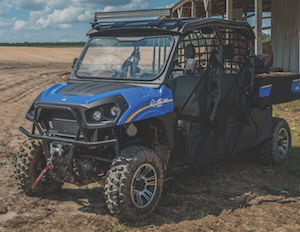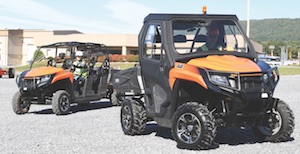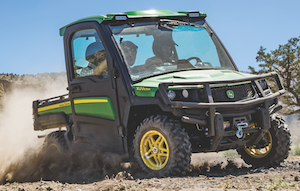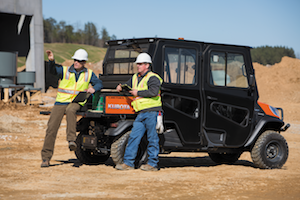Product Focus: Utility vehicles
Once considered more of an after-hours recreational vehicle, today’s compact utility vehicles (UTVs) are morphing into more powerful, more comfortable and more useful vehicles that provide all-terrain access for workers on a variety of job sites.
UTV professionals see an increasing demand for rental units, which offer rental centers additional business opportunities. Pro Contractor Rentals magazine queried leading UTV manufacturers on their take on the potential of UTVs in construction equipment rental operations; here’s what they report:
 |
Evolving design yields rental opportunities
-- Christopher Girodat, marketing manager, Bobcat Company
There has been a gradual increase of utility vehicle sales in the United States. This growth is due, in part, to the evolution of the design, performance, comfort and attachment capabilities of utility vehicles. Today, these machines aren’t being viewed just as a machine that can get operators from point A to point B, but as a true tool carrier to complete a variety of projects. This allows customers to be more productive, expanding their machine’s job site abilities.
Improved suspension and four-wheel disc brakes have been added to Bobcat utility vehicles providing industry-leading payload and towing capacity. A continuous variable transmission (CVT) and true four-wheel drive deliver quick machine acceleration and peak performance even when moving heavy loads. Hydrostatic drive systems, available on Bobcat 3600 and 3650 models, allow for better machine longevity, less maintenance and easier operation.
 |
| A PTO powers a variety of attachments, expanding Bobcat 3600 series models' versatility. |
An independent front dual A-arm suspension, with rear de Dion suspension, is found on all models for improved ride comfort and stability when towing or hauling heavy loads. The front suspension allows for 6 inches of motion, while the rear allows for 9 inches of articulation in the shocks/springs. The suspension can be adjusted to suit specific applications and jobsite conditions.
Bobcat utility vehicles provide three drive modes – turf mode, two-wheel drive and four-wheel drive – which help match the machine to varying ground conditions. In turf mode, each wheel spins independently, allowing for minimal ground disturbance. Two-wheel drive allows both rear wheels to receive equal torque and spin for added traction. Four-wheel drive allows the machine to easily navigate in shallow streams, travel in snow-covered paths and pull trailers.
Specific to the 3650 is the Multi-Attachment X-Change (M.A.X.) system, which allows operators to use approved front-mounted, PTO-driven attachments, including an angle broom, mower, snow V-blade and snow blower. The 3650 and M.A.X. system have a lift height of 2 feet and a lift capacity of 500 pounds. Non-PTO attachments – bucket, grapple, landplane, pallet fork and snow blade – increase versatility. A spreader attachment is available for 2017 3400, 3600 and 3650 utility vehicles.
There are a variety of utility vehicle options, so rental houses need to understand customer needs. Ask how customers will use the unit to find out if the unit will meet those needs.
To better promote these products, rental houses should also promote the fuel type, passenger capacity and hauling and dump bed capacities. Customers also might want enclosed cabs, heat and air conditioning and power steering, so promoting these features is also important.
The versatility of these machines should not be overlooked. The ability to provide customers with more specialized attachments can be valuable for those looking to rent a machine.
 |
Consider UTVs over pickup trucks
-- Norma Aldinger, marketing supervisor, Caterpillar
There is a significant trend with contractors to leverage utility vehicles for site support vs. pickup trucks. Beyond the lower cost, a lighter, more nimble vehicle tends to work better on a job site than a traditional pickup truck. Many contractors are renting units for the length of the project vs. capitalizing utility vehicles. This provides more flexibility and reduces the concern of product disposition after the job is completed.
Caterpillar has chosen to design a utility vehicle specifically for work. This includes a spacious, quiet operator environment, ability to safely handle loads, speed limiters and have optional job site accessories, such as telematics, beacons and backup alarms.
Rental houses can spur interest in utility vehicles by citing the economics of these units. Showcasing other customers who have successfully replaced pickup trucks with UTVs provides a benchmark for other customers to consider. Versatility on a job site with width restrictions and less damaging to the soil can also be promoted.
 |
Engineered for tough use
-- Mike Conley, strategic account manager, Club Car
Rental customers are demanding more durable, simpler and safer four-wheel drive vehicles, often with diesel engines and in four-passenger models.
Durability is especially important because the vehicles are used by various people on dirty construction sites. Renters need rugged vehicles with components that can take the heat in this demanding environment.
Air intake problems are a growing concern, as many utility vehicles draw in air on the back of the vehicle and close to the ground where the rear wheels roll up dirt and dust. They also use flat air filters that concentrate filtration on one spot. The result? Dirty oil, frequent filter changes and possibly costly engine failure.
As a result, rental centers are asking for air intake systems that sit high above the ground on the front of the vehicle, where intake air is cleaner. They also want systems with cyclonic filters that help reduce the chance of engine failure.
Rust is another worry. Once rust gets a foothold, it can eat right through steel frames. Many rental house are demanding rustproof aluminum frames for added durability.
They also want durable rear-suspension systems that pull heavy loads without sagging. The best of these are four-link semi-independent rear suspension systems that combine independent suspension performance with solid-axle strength.
Rental houses also demand simplicity and ease of operation. They like automatic four-wheel drive systems that sense the ground and shift as needed. They require little if any driver training and are easy to maintain.
Rental houses and renters want vehicles that can go as long as possible between maintenance schedules and offer easy access to service and parts. They want a single supplier that can offer access to 4x4s for construction and two-wheel drive rental-ready vehicles for light transportation around the yard or inside warehouses.
Finally, safety is an ever-growing concern, prompting the demand for vehicles with standard ROPS systems and safe speeds of 25 mph or less.
Because of the demanding environments, rental house are somewhat leery of new products and innovations that have not been well-tested in other markets. Their main focus in on increasing durability and simplicity.
At Club Car, our focus is on listening to the needs of our rental customers and making refinements and upgrades that solve their transportation problems, increase durability and keep their customers happy.
Rental professionals need to understand that there are vast differences in the build quality, durability and performance of various manufacturers’ vehicles. As a result, many contractors have experienced serious problems with rental utility vehicles, including rust, early engine failure and long waits for parts and service.
The best way to promote the use of these vehicles is to stock durable vehicles that do the work of pickup trucks, withstand the rental environment and satisfy customers. Compare individual components – frames, suspension systems, air intake systems, engines and brakes – to identify the best-built vehicles you can find. Rental houses can win business by demonstrating the vehicles’ capabilities – and limitations – to your customers.
Finally, make sure you offer vehicles backed by a dedicated rental support team with technicians that serve as a single point of contact, offer on-site and area training and troubleshoot issues by phone and in person.
 |
Reliability in rough conditions
-- Todd Debock, marketing manager compact tractors and UTVs, New Holland
Rental customers are demanding more from their compact utility vehicle rentals. They’re looking for units that are comfortable and easy to operate and rugged and capable enough to perform well in tough conditions. These customers are likely hauling the tools they need for work, so it’s important that the rental unit performs up to their standards.
Rental houses can better promote the use of compact utility vehicle to their customers by showing the units’ capability to meet their off-road needs. Instead of focusing only on the comfort of the machine or how easy it is to use, rental houses should show customers that their machines are reliable and ready to handle whatever conditions the renter might encounter.
 |
| The Rustler offers a four-passenger crew option. |
The New Holland Rustler utility vehicle was first introduced in 2016, with the addition of a four-passenger crew option joining the lineup at the end of 2017. These new machines include advanced features such as a push-button, on-demand front-wheel drive and differential lock to help the Rustler tackle the toughest terrain. Its progressive-rate suspension offers a comfortable ride whether it’s empty or fully loaded. The Rustler also is available in a new camouflage edition that might be desirable to hunters.
 |
Wide selection fits
diverse needs
-- Don Pieper, national account manager, Cushman
As compact UTVs have become increasingly widespread in the rental market, customers are demanding a more robust offering to help meet job-specific needs. Customers have recognized that a “one size fits all” approach is no longer the best and only option. Right-sizing the vehicle to the task means that customers can leverage resources more efficiently to optimize run time and operational cost. These efficiencies hold true for the rental houses providing customers access to these vehicles as well. As rental houses acquire a full selection of light-duty to heavy-duty utility vehicles, they can strategically manage their investment while meeting the needs of their specific customer.
In response to growing popularity, UTV manufacturers have responded with a wide selection of models, differing in terms of powertrain, payload, passenger seating and more. The Cushman brand, for example, offers more than 30 different vehicle models to address the demands of a variety of work environments. From fully-electric indoor burden carriers, like the Titan, to the more rugged, off-road Hauler series, to the Shuttle that offers seating to accommodate up to eight individuals, Cushman has a vehicle to suit any crew’s needs.
Options and accessories like a heated cab, aluminum bed or ladder rack can notably enhance crew comfort and boost productivity. Moreover, the introduction of simple advances to creature comforts – like USB ports for charging devices or oversized cupholders – take a standard UTV from a task runner to a true all-day, truck-like work vehicle. It can be expected that the market will continue to expand offerings with a focus on driver experience, safety and versatility.
Rental houses can promote the use of compact UTVs to customers by embracing this trend. Highlighting UTV versatility, ease of use and safety features will help encourage customers to take advantage of rental opportunities. Further understanding and offering the best vehicle model for that customer’s needs while demonstrating how these nimble yet comfortable UTVs can add productivity to every day operations will also support new opportunities. With generally low operational costs and limitless applications on the work site, UTVs can quickly add value and power to boost any crew’s productivity.
 |
Ask questions to select the right UTV
-- Jeff Ford, director of global strategy and business development, JLG Industries, Inc.
The demand for compact utility vehicles is increasing as their versatility on job sites becomes more apparent. The vehicles provide an efficient means of moving people and materials around large construction sites, convention centers, event venues and commercial business parks. Often, they are able to travel across terrain or through tight spaces that larger, heavier, more traditional vehicles are not able to navigate. They are also able to haul more in fewer trips, contributing to job site efficiency and productivity.
In March 2017, JLG Industries Inc. entered a new product
 |
| JLG entered the utility vehicle market in 2018 with its three-seat 315G and six-seat 615G models. |
category with the launch of two utility vehicles—the three-seat 315G and six-seat 615G. They feature a number of advances in vehicle design, including a 10-inch ground clearance with four-wheel drive and an independent suspension to keep all four wheels on the ground during travel, delivering superior traction and balance. While in operation, drivers can shift between two-wheel and four-wheel drive and locking the differential for improved traction. Durability is further enhanced by rugged axles, standard skid plate, brush guard bumper, and a heavy-duty powder-coated steel frame.
The JLG 315G and 615G have substantial cargo capacities with a 1,000-pound capacity cargo box and 1,500-pound towing capacity, which are important in today’s job sites. The cargo bed side panels can be removed to accommodate a full-size skid. Operators can carry more material, reducing the number of trips around the worksite.
These vehicles also include a number of standard features demanded by today’s operators, including contoured seats and foot beds, individual headrests and seatbelts, power steering and backup alarm. Operators can choose from additional options, such as an enclosed cab, heater, windshield and beacon for even greater comfort.
As rental customers begin to use compact utility vehicles and experience firsthand the benefits they offer, it will be easier to promote their use. And, in the case of JLG compact utility vehicles, rental houses and their customers benefit from the convenience of a single-source equipment supplier and the peace of mind that comes with knowing their investment is backed by JLG’s comprehensive parts, service and support network.
The successful application of compact utility vehicles depends on answers to the following questions: What do you want to move around the job site? How many people and how much material will you want to move? In addition, what type of terrain will you need to traverse going around the job site? Will it be a hard surface, like concrete; an improved surface, like rough limestone; or rough terrain? Lastly, understand the type of fuel that will be available on the job site, and the size and weight of what needs to be hauled and towed. Seeking answers to these questions will help customers make the best decision when purchasing or renting a utility vehicle, ensuring a successful application and making it easier to promote their use in the future.
 |
Comfort wanted
-- Kevin Lund, product line marketing manager for UTVs, John Deere
While many factors go into selecting the right UTV for a job, there are a few key areas that rental customers tend to focus on: cost, capacity and maintenance.
Most rental customers are using utility vehicles for transport jobs, so many customers are focused on the number of employees that can comfortably travel in a utility vehicle, for an affordable price.
One new trend we have seen in the industry is the increased focus on comfort. Understanding the long hours spent in a vehicle on a job site, rental customers are focusing more on comfort as it helps operators be more productive on the job site.
 |
| John Deere Gators are available in diesel and gasoline-powered models. |
John Deere offers a wide range of utility vehicles to meet the needs of professional contractors. From the traditional work series line, including the HPX, TE, TH, TS and TX models, to the crossover offerings, John Deere has a model that can tackle any job.
Most recently, John Deere unveiled its newest addition to the Gator lineup, the XUV835 and XUV865 utility vehicle models. The gas-powered 54 horsepower Gator XUV835 and diesel-powered 23 horsepower Gator XUV865 utility vehicles feature a quiet cab, three-wide seating, improved ergonomics and exceptional heating and air conditioning. They are ideal for working in winter conditions.
Customers are asking for durability, lower noise levels and comfort and that is driving UTV innovation. When using utility vehicles for jobs, durability is important to increase uptime and lower daily operating costs. One area that is continuing to be evaluated is tires, and ways to limit mishaps, increase productivity and lower overall maintenance costs.
Electric models are gaining interest among customers that can be used for indoor and outdoor jobs. In areas where noise is a concern, electric vehicles offer a solution to move people without disrupting the environment.
Comfort has grown increasingly important, particularly as more work sites are focusing on retaining employees. Comfortable utility vehicles increase operators’ happiness and productivity, which is ultimately positive for the business. By selecting a machine equipped with a cab, including air conditioning and heat, operator comfort is increased, as is productivity. The John Deere XUV835 and XUV865 are equipped with cabs and standard heating and air conditioning, providing protection for operator and options to increase comfort.
One of the easiest ways rental companies can promote the use of compact utility vehicles is by educating customers. Rental companies should never assume that customers are aware of every machine that is available through a rental center. By speaking with customers about the projects they are working on, rental companies can identify opportunities to promote the benefits of utility vehicles.
Additionally, identifying compatible products, such as equipment including compact excavators, compact track loaders and skid steers, utility vehicles can be further promoted as a solution for work sites.
 |
| Kubota’s RTV-X1140 features a K-Vertible cargo conversion system that transforms the vehicle wfrom two passengers and a large cargo bed to four passengers and a cargo bed. |
Multiple passengers, multiple tasks
-- Roger Gifford, product marketing manager, UTVs, Kubota
Customers who rent utility vehicles are often looking for units that are multi-taskers – especially machines that can help them get their job done efficiently and also haul people around a job site. Utility vehicles that can hold multiple passengers is now a common demand of rental customers.
Kubota’s RTV-X1140 features an innovative Kubota K-Vertible cargo conversion system that transforms the vehicle with minimal effort from two passengers and a large cargo bed to four passengers and a cargo bed.
One of the newer advances in Kubota’s utility vehicle line is a four-point PTO K-Connect for the RTV-X1100C that can power attachments such as snow blowers, rotary brooms and blades, transforming it into the ultimate snow removal machine.
With K-Connect, these new implements connect in seconds without tools and can be removed easily for seasonal storage. The gear-box driven PTO is durable, requires less maintenance and offers quieter operation.
The control handle and PTO switch offer simple and intuitive control and is designed for left- or right-hand operation, with a blue LED indicator that confirms the floating action of the hitch for immediate use.
Rental centers report that contractors rent utility vehicles instead of trucks for some applications and specific job sites. Utility vehicles can serve in the same function as a truck on a work site, yet the operating costs, fuel efficiency and maneuverability around a job site is even more task- and cost-efficient, making it a great choice.
 |
| Polaris UTVs can feature GPS tracking and geo-fencing. |
Increasing demand for technology
-- Jamie Juliano, senior manager, national accounts, Polaris
Customers continue to demand timely delivery of durable products with strong back-end support for service. As Polaris continues to enhance our partnerships in the rental industry, the drive for implementation of product enhancements and life-cycle cost improvements is constant.
Technology advances have been rapid, and in many ways, mirror the automotive industry and certain construction equipment categories. Advanced fleet management tools such as diagnostics and service interval monitoring, GPS tracking and geo-fencing are becoming more commonplace as technology costs continue to fall. It’s not unreasonable to assume autonomous and/or remote operation is on the horizon. All of these advances are exciting, but must be balanced with the ever-present need to put a durable and cost-effective products on the ground.
UTVs provide an essential function of cost-effective, all-terrain mobility on a wide range of job sites. In many cases, the acquisition and operating costs of a UTV can be fraction of the cost of an on-road vehicle while offering superior capability in rough terrain over trucks.
Copyright 2018 Direct Business Media. All rights reserved.









